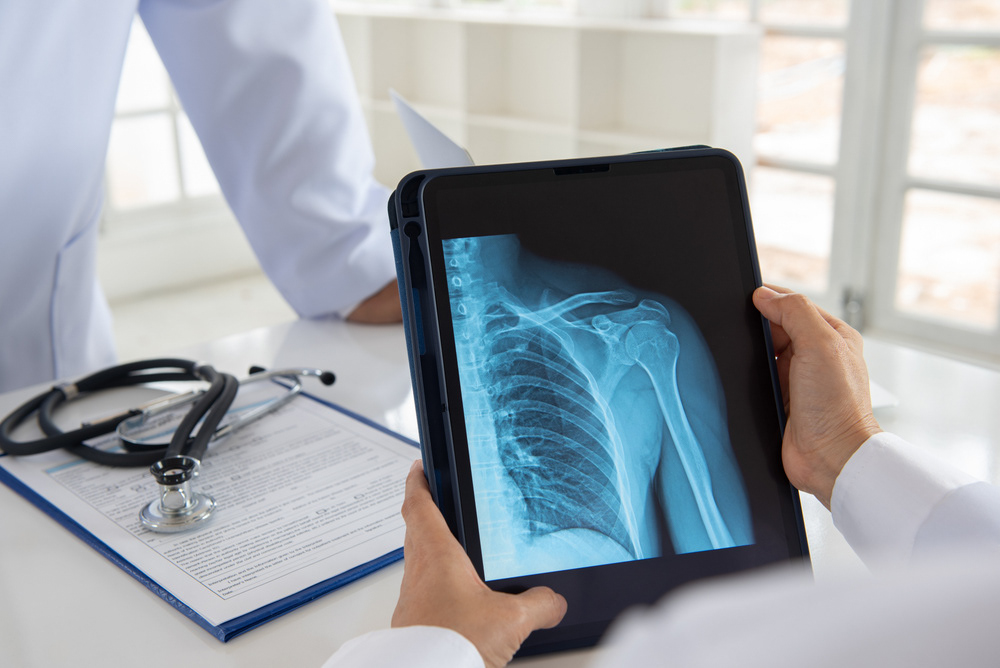What is Digital X-Ray and Portable X-Ray
X-ray refers to a type of electromagnetic radiation that has a shorter wavelength and higher energy than visible light. X-rays are able to penetrate materials that visible light cannot, making them useful for various applications, including medical imaging, security scanning, and materials testing.
In medical imaging, X-rays are used to create images of bones and other internal structures of the body. This is achieved by passing X-rays through the body and capturing the radiation that emerges on the other side with a detector. The resulting image shows the relative density of the tissues within the body. While X-rays are generally considered safe in small doses, repeated exposure can increase the risk of cancer and other health problems. Therefore, medical professionals take precautions to limit the amount of radiation patients receive during X-ray procedures.

What is Digital X-Ray and Portable X-Ray
Digital X-ray is a type of medical imaging technology that uses digital sensors to capture and produce images of the body. In digital X-ray, the X-ray beam is passed through the body, and the resulting image is captured by a digital detector that converts the X-ray energy into an electronic signal. This signal is then processed and converted into an image that can be displayed on a computer screen or printed. Compared to traditional film-based X-ray technology, digital X-ray offers several advantages, including faster image acquisition, higher image resolution, and the ability to easily manipulate and share digital images. Digital X-ray systems are commonly used in medical facilities for a variety of diagnostic purposes, including the detection of bone fractures, the diagnosis of lung conditions, and the screening for certain cancers.
Portable X-ray, also known as mobile X-ray, is a type of X-ray technology that is designed to be easily transported and used in various locations outside of traditional medical facilities, such as hospitals or clinics. Portable X-ray machines are typically smaller and more lightweight than traditional X-ray machines and are equipped with wheels or handles for easy movement. These machines can be used for emergency situations, such as on-site imaging of trauma victims, or for patients who are unable to leave their home or bedridden. Portable X-ray machines may use either traditional film-based technology or digital technology, depending on the specific machine. Digital portable X-ray machines are becoming increasingly popular due to their advantages, such as the ability to produce high-quality images quickly and the ability to store and transmit images electronically for remote interpretation.
Benefits of X-Ray
X-rays are a form of electromagnetic radiation that has been used in medical imaging for over a century. They are a powerful tool that allows doctors to see inside the human body and diagnose a variety of medical conditions. In this article, we will explore the benefits of X-rays and how they have revolutionized the field of medicine.
1. Diagnosing Broken Bones and Fractures
One of the most common uses of X-rays is to diagnose broken bones and fractures. X-rays can quickly show the location and severity of a fracture, allowing doctors to create a treatment plan. Without X-rays, it would be difficult for doctors to know the extent of the injury and how to properly treat it.
2. Identifying Tumors
X-rays can also be used to identify tumors in the body. By taking an X-ray of a particular area, doctors can look for abnormal growths or masses that could be cancerous. This early detection can be critical in the successful treatment of cancer.
3. Detecting Dental Problems
Dentists use X-rays to detect dental problems that may not be visible during a routine exam. X-rays can show decay between teeth, gum disease, and other oral health issues. By detecting these problems early, dentists can provide appropriate treatment and prevent more serious issues from developing.
4. Guiding Medical Procedures
X-rays can also be used to guide medical procedures. For example, a doctor may use an X-ray to guide a needle during a biopsy or to guide a catheter during a heart procedure. By using X-rays, doctors can ensure that they are targeting the correct area and avoid damaging surrounding tissue.
5. Monitoring the Progress of Treatment
X-rays can be used to monitor the progress of treatment. For example, after a bone has been set, X-rays can be taken to ensure that the bone is healing properly. Similarly, X-rays can be taken during cancer treatment to monitor the size of tumors and the effectiveness of treatment.
6. Non-Invasive
X-rays are a non-invasive way to diagnose and monitor medical conditions. Unlike surgery or other invasive procedures, X-rays do not require any incisions or anesthesia. This means that patients can avoid the risks associated with more invasive procedures.
7. Quick Results
X-rays provide quick results, making them a valuable tool in emergency situations. For example, if a patient has a suspected broken bone, an X-ray can be taken immediately to confirm the diagnosis. This allows doctors to quickly create a treatment plan and begin the healing process.
8. Widely Available
X-rays are widely available, making them accessible to patients all over the world. X-ray machines are found in hospitals, clinics, and medical offices, and can be used to diagnose a variety of medical conditions.
9. Cost-Effective
X-rays are a cost-effective way to diagnose and monitor medical conditions. Compared to other medical imaging techniques, such as MRI or CT scans, X-rays are generally less expensive. This makes them a valuable tool in countries with limited healthcare resources.
10. Safe and Effective
X-rays are a safe and effective way to diagnose and monitor medical conditions. While there is some risk associated with exposure to radiation, the amount of radiation used in X-rays is minimal. Additionally, the benefits of X-rays often outweigh the risks, making them a valuable tool in the field of medicine.
